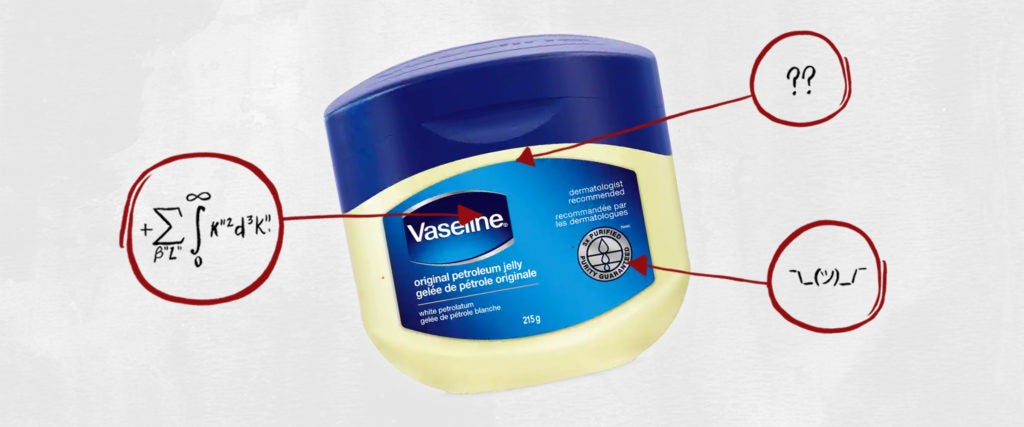We’re often told that you should never eat anything (or put anything on your body) if you don’t recognize everything on the ingredients list. But since most of us have no idea what xanthan gum or potassium benzoate are — or more importantly, what they’re doing to our bodies — we’re decoding the ingredients in the many things Americans put in (and on, or near) themselves.
This edition: Vaseline Healing Jelly, which is made from only one ingredient that we’ve broken down as it appears online.

The Ingredient
1) White Petrolatum, USP: More commonly known as petroleum jelly, white petrolatum was first discovered in 1859 by a young British chemist named Robert Augustus Chesebrough. Chesebrough traveled to a small Pennsylvania town where petroleum had just been found, and he noted a syrupy goo collecting on the oil rigs. It came up alongside the crude oil, and the oilmen had apparently been smearing it on their skin to help mend cuts and burns (which seems reckless, but hello, 1859).
Eventually, Chesebrough devised and patented a vacuum distillation process, which is still used by Vaseline, to purify and clarify the gummy substance into a more refined mixture of mineral oils and waxes. The end result is mostly a combination of hydrocarbons, a class of organic chemical compounds composed only of the elements carbon and hydrogen. Simple, right?
Chesebrough had quite a lot to say about the alleged healing powers of white petrolatum back then. He was famous for using himself as a guinea pig, cutting, stabbing, burning and even pouring freaking acid on himself before treating the wounds with his supposed wonder-salve. And people ate it up!
In hindsight, we know that white petrolatum is no miracle ointment, nor does it necessarily heal wounds exponentially faster than they would on their own. What it does is simply insulate and moisturize trauma to the skin to prevent infections and excessive scabbing, which is still a good thing, but again, no miracle. That said, many medical professionals recommend petroleum jelly over antibiotic ointments like Neosporin for your basic first aid needs.
There are, however, some concerns about petroleum jelly being carcinogenic in certain cases, since it can contain hydrocarbons and polyaromatics found in crude oil that may be cancerous. Vaseline is supposed to be devoid of these thanks to its purification process — their product is triple-purified and regarded as non-carcinogenic — but there are many imitators that may be less regulated. So, stick to the good stuff.
Now, there are some wild rumors out there about how Vaseline can be used. For instance, a lot of people want to know, does vaseline help grow your eyelashes? The answer is, hell no! Again, Vaseline basically just seals in moisture, and while moisturizing your lashes may make them appear fuller and lusher, it won’t make them grow longer or faster.
Using petroleum jelly as a lubricant is also a terrible idea. It can increase your risk of bacterial infections, weakens condoms and is a huge pain to wash away. If you need lube suggestions, check out our lube guide.
The Takeaway
Vaseline can be a great product for sealing moisture into your skin, which can help keep bacteria from invading minor cuts and scrapes, soothe chapped lips and fix up any of your extra dry bits. But don’t expect much more.

